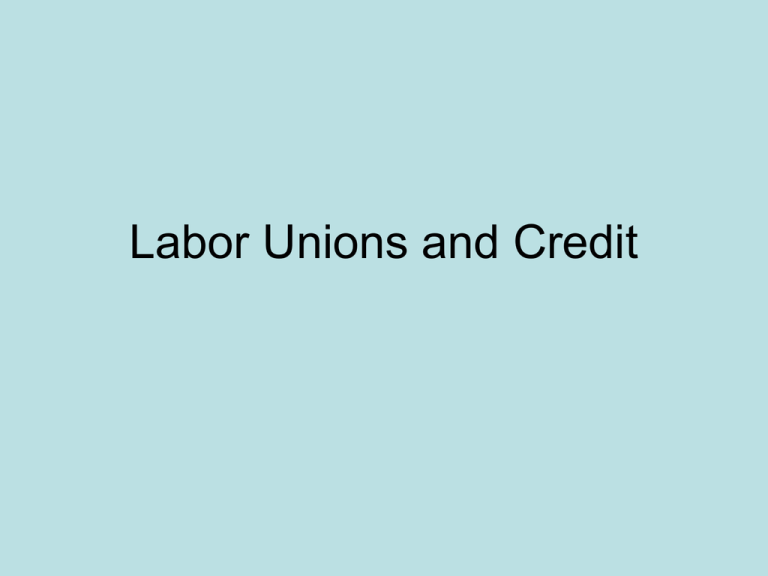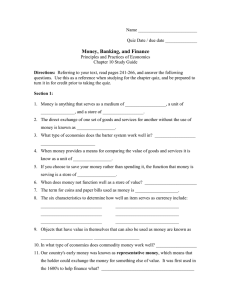Labor Unions and Credit
advertisement

Labor Unions and Credit Labor Unions • Association of workers organized to improve wages and working conditions for its members. • A group has more power than an individual. Development • Poor working conditions in factories in the 1800’s. • Workers were fired for no reason. • Workers were often blacklisted. Knights of Labor • Founded in 1869. Attempted to organize all laboring people. • Terrence V. Powderly became their leader after 1879. • Membership increased to 700,000 between the years 1885-1886. • Began to decline and ended in 1900. American Federation of Labor • Organized in 1886. • Accepted only skilled workers. Women, AfricanAmericans, and immigrants were not accepted. • AFL had separate unions for different crafts. • Samuel Gompers was president of the union. He wanted higher wages, shorter hours, and benefits for disabled workers. • Between 1890-1900, membership reached 500,000. Union membership policies • Closed Shop: Companies hire only union members. • Union Shop: Worker must join the union after a specific time period. • Agency Shop: Not required to join the union, but must pay dues. • Open Shop: Companies may hire workers regardless of membership. Collective Bargaining • Process where union leaders and employers discuss employment terms. • Compromise is the main issue. • Three steps: Negotiation, mediation, and arbitration. • Negotiation: Labor and management meet to discuss contract issues. • Mediation: A neutral person helps both sides reach agreements. The Federal Mediation and Conciliation Service will provide a mediator. • Arbitration: Two sides submit issues to a third party for a final decision. When Collective Bargaining Fails • Strike: Workers refuse to work. – Picketing: Discourage workers from working. – Boycott: Refuse to purchase goods or services from the company. – Scab: Worker willing to work on company terms. • Lockout: Management prevents workers from working. Credit • Receiving something with the promise of payment at a later time. • Principle: Actual cost of the good or service. • Interest: Amount paid for the use of money. Charge Accounts • Buy goods and services at individual stores and pay for them later. • Credit limit: Maximum amount a person can buy with the promise of payment at a later time. • Three types of accounts are installment, regular, and revolving. Account facts Installment Account Regular Repaid with equal amount. A bill is sent at end of cycle. Mortgage: Loan on property. Can not be used again until the balance is paid off. Revolving A bill is sent at end of cycle. Can continue use as long as the balance is below credit limit. Credit and Debit cards • Credit cards: Make purchases without cash. – Used to purchase items and receive loans. – Charge high interest rates (Avg. 18%) in the 1990’s. – Lower interest rates if the customer is “reliable”. • Debit Cards: Transfer funds electronically. – Popular use in Automated Teller Machines (ATM’s) – Now can be tied directly to checking accounts (check cards) Applying for credit • Fill out an application. • Credit Bureau will do a credit check. Creditor will ask for references. • This check gives your income, debt, and ability to pay debts in the past. Credit Rating • Rating of risk: Excellent, good, average, or poor. • This gives the lender an idea of reliability. • They also look at capacity to pay, character, and collateral. • A secured loan is a loan based on collateral, something the borrower is willing to give up if the loan is not paid back. • An unsecured loan is one based on reputation. Government Regulations • Equal Credit Opportunity Act: A person can not be denied credit because of race, religion, national origin, gender, marital status, or age. • Usury laws: Restrict the amount of interest companies can charge. Bankruptcy • When debts are so large, that they can not be repaid. • Most of what debtors own is given to creditors. • It is very hard to re-establish credit. Financial Institutions • Commercial banks: Main functions are accepting deposits, lending money, and transferring funds. • Savings and loan: Very much like commercial banks. Normally smaller banks. • Savings banks: Original purpose was to help those overlooked by large banks. Sometimes charge higher interest rates. • Credit Unions: Offer high interest on saving and low interest on loans. Must be a member to use their services. • Finance Companies: Charge high interest rates. Used by those with bad credit history. Finance Charges and Annual Percentage Rate (APR) • Finance Charges: Cost of credit expressed in dollars. • APR: Cost of credit as a percentage. May differ from place to place.

